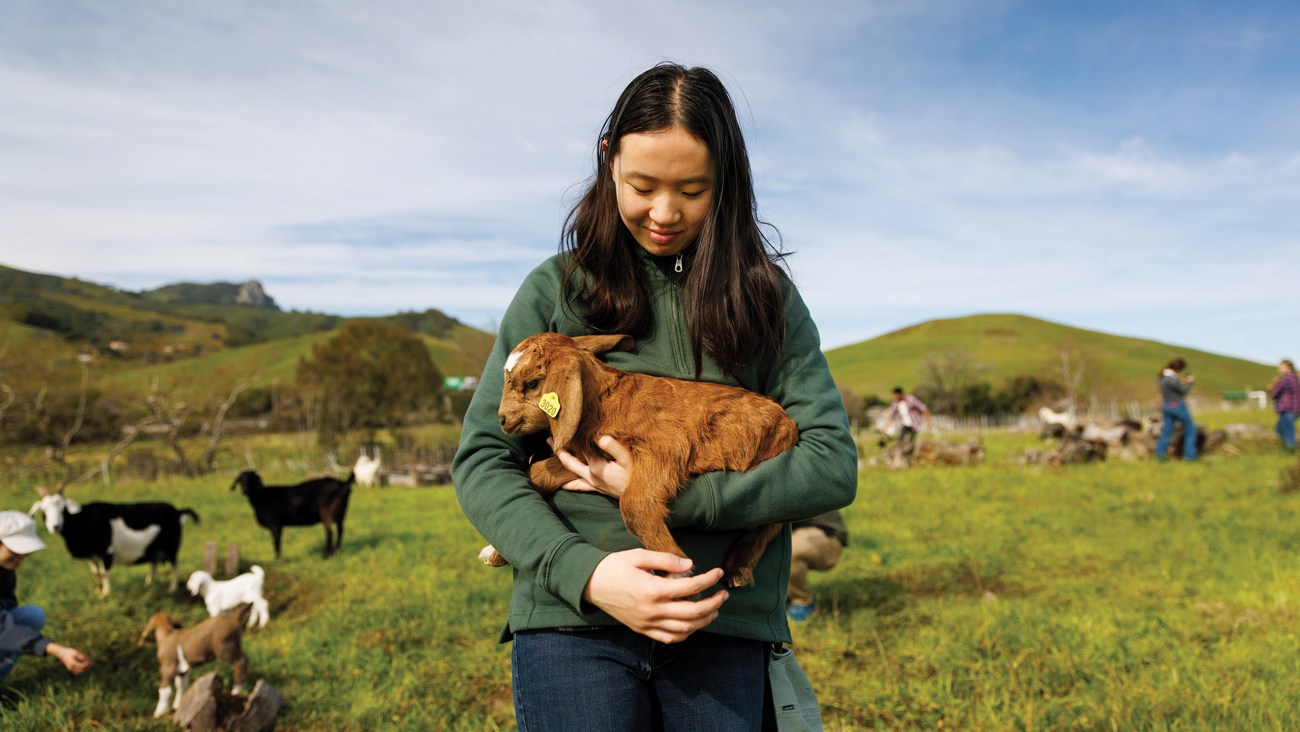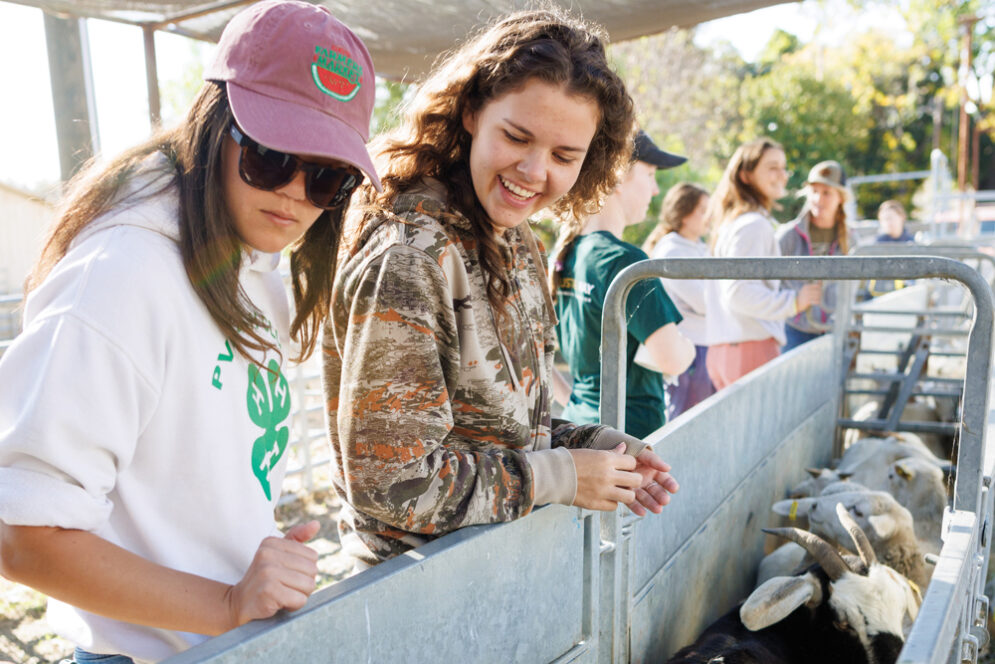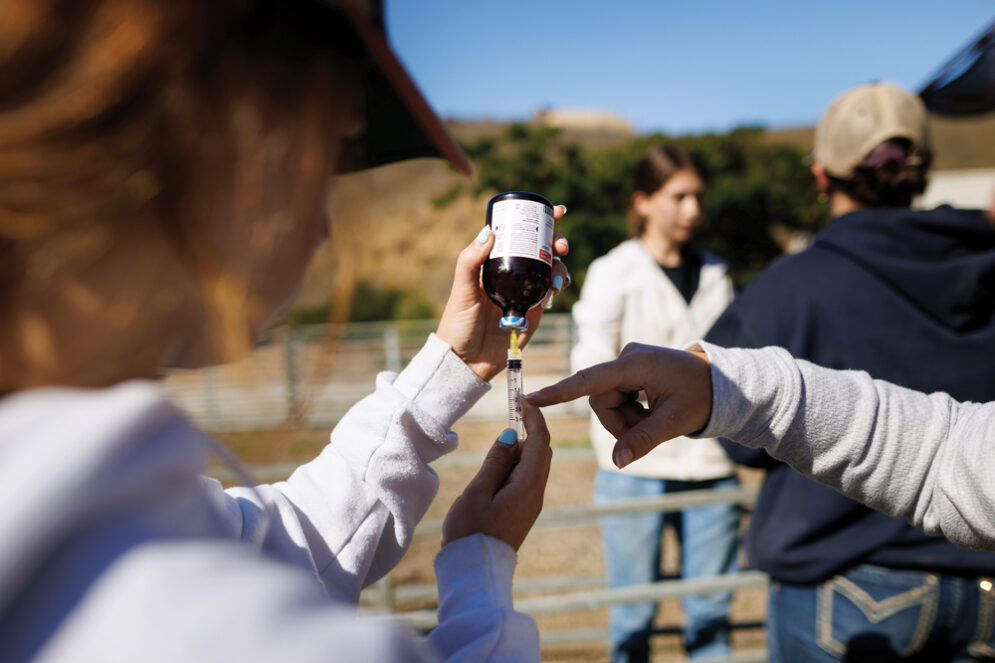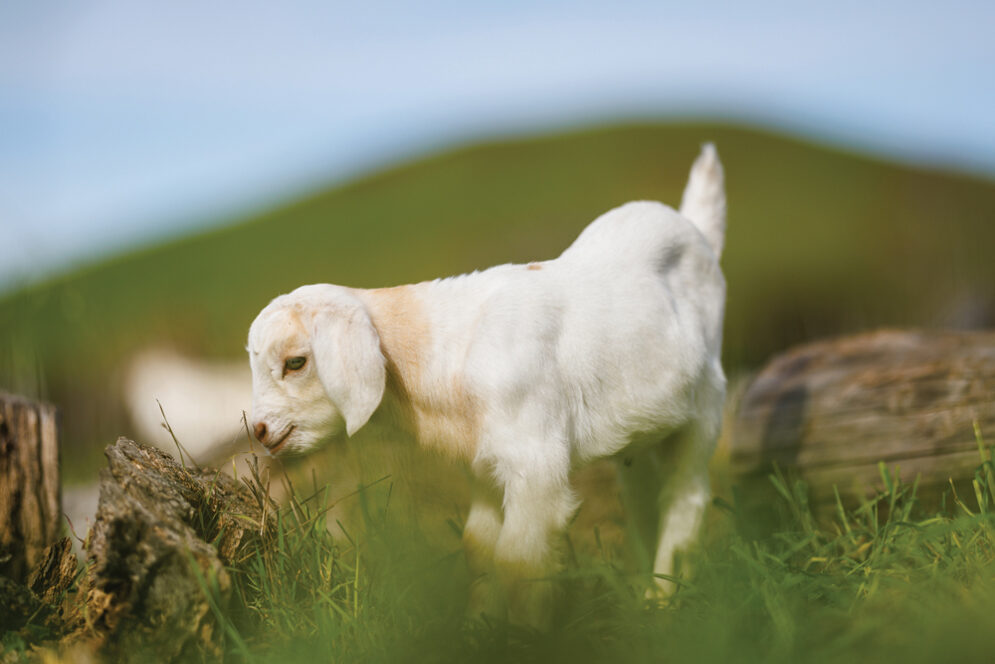The Kids are All Right
Go behind the scenes of the goat enterprise, ASCI 290, where students learn how to care for goats at different stages in their lives.

One of the liveliest classes on campus is tucked away in a nondescript complex of farm buildings nestled among grassy hills. You might hear the occasional indignant baa and then you see them: sheep and goats, barely waist-high and radiating attitude.
Cal Poly’s sheep and goat facilities are home to a signature Learn by Doing experience available to any student willing to get their hands dirty: the goat enterprise, ASCI 290.
“The students learn a range of things depending on the quarter, because we go through a full year of production,” said Beth Reynolds, the program director. There’s a broad scope of subject matter too: students can learn anything from breeding preparation to grazing practices and even how to raise and care for baby goats.
It’s a particularly key class for students who hope to go on to veterinary school or otherwise work with animals in the future — many of whom take the enterprise, according to Reynolds. And it’s especially good for first-year students.
“A lot of our students come into the enterprise who have no experience with animals and they want to be vets,” she said. “The goats are perfect for learning: they don’t kick, they don’t bite, they’re not intimidating.”
From the first day of class — regardless of experience level — the students are thrown right into it.

Students in the fall 2022 enterprise class observe as the youngest members of the flock are herded into a chute for vaccinations.
On one golden fall day, the barn is raucous as students separate out the youngest members of the flock and herd them into a chute. The goats are weighed and given a de-wormer and a supplement cocktail of copper and selenium for increased fertility. The goal: get the goats vaccinated and ready to breed.
“I feel on top of the world!” exclaims second-year animal science student Hunter Marquardt, who had just performed her first veterinary medical procedure when Reynolds called her over to the chute to administer an injection to one of the young goats.
It took a second for Marquardt to find just the right spot for the needle: she had to examine the hindquarters and pinch up the skin to get it in the correct place.

Using a syringe, a student prepares a dose of a vaccine for her goat patient during the fall enterprise course.
“I love being able to be so hands-on in this class,” she says. “Learn by Doing is literally what we’re doing every day.”
San Diego native Mackenzie White, who hopes to be a veterinarian, had never handled farm animals before taking the enterprise. She started giving the goats injections during the first week of school.
“The most I had done was seen a goat at a petting zoo,” White, an animal science student, says. “I was thrilled, and I was thrown right in.”
One February morning in the middle of winter quarter, the students meet first at the barn, where a sick ewe is awaiting care. Reynolds, carrying medicines, demonstrates how to treat the ewe and asks the students their opinions on the best methods to care for the animal.
Once the ewe is squared away, she pauses, looks out at the group, and asks: “Anyone want to see some baby goats?”
The students cheer, trekking out of the barn, up a hill through muddy earth, crossing a small stream to reach a secluded patch of grass, where babies frolic among tree stumps and rubble. Bishop Peak stands guard in the background. The students assess the kids, while the mother goats keep a watchful eye.

One of the kids born in winter 2023 walks toward a log in the pasture in February.
Two first year animal science students, Nathan Zoloto and Maya Christie, check on a few of the kids near a fallen log. Both students grew up near cities— Zoloto is from Chicago and Christie is from LA — and neither had any livestock experience before the enterprise.
“At other universities, you can’t get this much hands-on experience right at the start,” Christie says. “Beth has done a great job teaching us the ropes: we’ve done vaccines and ear tags but also more management too, like helping with feed, separating herds and preparing for birth.”
Over an exceptionally rainy winter quarter, students steadfastly care for the babies through illness and a damper than usual climate. A few weeks down the line, they castrate the kids.
“We make sure the animals’ welfare is monitored and we’re not unnecessarily stressing them out,” Reynolds said. “But I’m a big believer in just throwing the students in and doing it.”
Spring is the busiest time: now that the babies are growing into juveniles, there’s work to be done to maintain a healthy, happy herd. One day, that means building a new pasture and learning about range management. Next class, it could mean hiking Poly Canyon to identify plant material for grazing. Or it could mean collecting and analyzing fecal samples to make sure the animals are getting the nutrients they need to stay healthy.

Goats await their vaccinations during an enterprise class in fall 2022.
Animal science major Claire Fitzgerald’s first experience working with goats wasn’t positive. But after taking a class on small ruminants with Reynolds last winter, she was willing to give it another shot. Fitzgerald needed to take an enterprise class in the spring, and felt inspired to continue working with goats.
She loves learning about regenerative agriculture through the class, which is the process of using goats to chew down crops, taking carbon out of the atmosphere and putting it into the ground. She has also signed up to become a program manager for Cal Poly’s goats.
“I’ve really enjoyed being out here,” she says. “You don’t get this on the main campus.”


